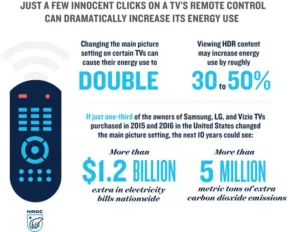The Natural Resources Defense Council (NRDC) in the US, a non-profit environmental lobby group that claims more than two million members, has published a report that claims that Samsung, LG and Vizio are exploiting loopholes in the regulations for energy consumption. It was a follow up on work done on UltraHD TV sets that seemed to echo issues seen last year in European testing of TVs. (VW Scandal Revived in Samsung Sets). This related to dimming during the display of moving content, so the NRDC bought some TVs and tested them. They also looked at other sets in stores.
A second point was to check if settings that users implemented in terms of picture quality caused the low energy features to be disabled.
The report effectively claims that Samsung and LG detect fast changing content, that resembles the IEC standard 10 minute clip used for testing and which has 260 different scenes in that time (a new scene around every 2.29 seconds) and dim the display to reduce the power used. The Vizio TV doesn’t have the feature. The NRDC compiled its own clip of typical scenes that change around every 3.89 seconds. The sets did not switch to the low brightness mode when the NRDC clip was played, so power consumption was much higher – and figures of 13%, 15% and 58% were quoted for the three TVs tested using the IEC standard test sequence.
The group also tested automatic brightness controls which can reduce power consumption and how they are affected by changes in picture setting. Switching to a sports or vivid mode disables energy saving features in all the three TV sets tested, but NRDC points out, consumers are not warned about the effect on power consumption. The group also said that Samsung sets drop their energy saving features when viewers changed the backlight brightness in any way. On the other hand, sets from Sony and Philips maintained the energy saving features when settings were changed and NRDC praised this as an “industry best practice”.
NRDC then went on to describe the impact of some of these issues. It said that if a third of consumers changed their picture settings, the power used is enough to power Los Angeles for a year.
Finally, the test looked at whether HDR content impacts power consumption. It found that HDR content played back on HDR sets* used 30% to 50% more power than playing the same content in SDR and there is no current test for HDR content in the official regulations. It also found that efficiency techniques are disabled when sets switch to HDR.
The group would like to see new tests for HDR and for the persistence of energy saving features.
The CTA in the US responded aggressively to the report and Gary Shapiro said “Today’s report is consistent with NRDC’s typical approach—sensational-but-meaningless headlines, facts either misstated or irrelevant to the claims and an inexplicable hostility to an industry that has done so much to reduce energy usage,” said CTA president Gary Shapiro.
“NRDC continues to wrongly claim mythical energy savings from the California regulations it pushed for, when in fact the history of technology proves that innovation has driven fundamental changes in video screen technology – a process NRDC had nothing to do with”, he continued.
“The TV settings used in the energy efficiency testing processes can be and are used in the real world, unless consumers want a different viewing experience – any deception here comes only from the NRDC, and we hope its board and contributors begin an internal investigation into this misplaced hostility toward energy-efficient technology, blockage of science-based policy and personal vendetta by NRDC’s so-called scientists.”
* NRDC did not make it clear if this was sets that are HDR-enabled or are capable of the extra brightness needed for true HDR
Analyst Comment
NRDC said that as far as it knows, only LG and Samsung are using the motion detection feature, but they haven’t done exhaustive testing. It also said that better design of automatic brigthness controls might mean that consumers could be happier with the image without disabling them.
Clearly, while not illegal, the ‘gaming’ of the system by LG and Samsung is seen as ‘sharp practice’ and NRDC called for a change to test methods to make this harder. From my point of view, the blanket attack by the CTA on NRDC doesn’t seem to be a very clever way of dealing with this issue. (BR)

